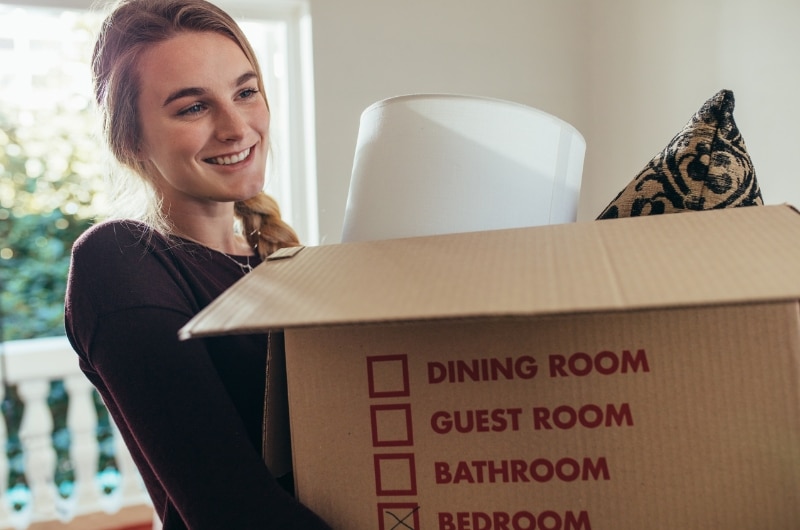
Prefer not to leave your phone number?
No problem!
Schedule an Appointment at your Convenience
(Only email is required)
Schedule an AppointmentOr Call Now
844-545-1881By: Last Updated: Jan 01, 2025
Prioritize proper packing and cushioning, invest in quality packing materials, and use custom crates when needed. Hire professional movers to ensure a productive transition.

When moving into a new home, you want to make sure your delicate belongings arrive safely. This article will help you navigate how to pack specific items like fine china, glassware, and artwork to make sure they arrive safe and sound.
You’ll know what to do when things go wrong because in this article we give you the proper steps on how to handle broken items.
Before you start packing for your move, take a moment to list all your fragile and valuable items. Snap a few pics too—trust me, if the unfortunate happens and something breaks or disappears, you’ll be glad you have that inventory for insurance claims.
Early planning is key, especially for delicate items like glassware, electronics, and antiques, which require special attention. Grouping similar fragile items together when packing not only streamlines the process but also enhances their protection.
Remember, this isn’t just about moving stuff; it’s about moving memories. So, take your time and pack carefully.
Remember, this is not the place to cut corners; high-quality packing supplies can mean the difference between your fragile items arriving safe and sound or in pieces.
Here’s a list of packing supplies to invest in:
Check out local stores or Amazon for these supplies. If you want the best advice for materials tailored to your moving needs, we suggest asking professional cross-country moving companies. They have years of expertise and know the ins and outs of professional packing for fragile items.
When it comes to packing your fine china or dishware, a great first step is to sort similar items together. Group all your plates, bowls, cups, and saucers, respectively. Wrap each piece in tissue paper, sorting them by type and size for easier organization. Use scotch tape over packing tape to secure the tissue because packing tape might tear through the tissue.
After wrapping the items in tissue, give each item an extra layer of protection with bubble wrap, ensuring it’s completely covered and cushioned. The china should be fully padded to where you can’t feel it.
For stacking china plates, consider their weight. Limit stacks to no more than five plates for heavier items, but for smaller plates like saucers or bread plates, they can be stacked up to six. Trust your judgment and adjust accordingly.
For each glass or piece of stemware, use packing paper, unprinted newsprint, or bubble wrap for individual wrapping. Use a small piece of scotch tape to keep the wrap securely in place. To avoid damage, it’s ideal to place glasses and delicate items into individual boxes designed for their protection.
When storing your everyday glassware, ensure the space is dry and free from dust and pests. As tempting as it might be to maximize cabinet space by packing glasses tightly, giving them some space is key. This approach helps to avoid scratches and reduces the risk of damage.
Exposure to air can cause silverware to discolor, making it essential to wrap each piece, whether it be flatware or coffee sets, in tissue paper. For loose silverware, bundle them in groups using clear plastic, tissue, or packing paper for extra security.
For silverware stored in a chest, consider wrapping each item individually before placing them back to offer more protection. Fill any voids in the chest with tissue paper or clean paper towels, and wrap the entire chest in a large blanket or bath towel for additional safety during the move.
Extended exposure to direct sunlight can lead to fading and deterioration of photo quality. To maintain the pristine condition of your vintage photos during relocation, shielding them from light is key.
For unframed photos, storing them in a dark, protective container like a Solander Box is ideal. Ensure any storage solutions, like scrapbooks or filing cabinets, are marked as “acid-free” to preserve your memories safely.
Try to handle artwork as little as possible. Finger oils can damage artwork by leaving smudges and oily residue. Especially when caring for prints and works on paper, you can greatly reduce the risks of creases, bends, or smudges by carrying paper by the two corners or by supporting the work from underneath, rather than pinching it.
It’s also important to remember to only lean canvases against a flat surface. Leaning the front or back of a stretched canvas against a sharp or pointed object, no matter how small, will leave a dent that could irreparably damage the piece.
If you lean a work of art against anything, make sure to lean it on the wood of its stretcher bars to ensure that nothing presses against the canvas.
After boxing up your items, it’s important to clearly mark each box with your name, what’s inside, and an upward arrow to show it shouldn’t be tipped on its side.
Also, write “FRAGILE” or “HANDLE WITH CARE” with a bold marker on at least 2 sides of the box.
Thinking about handling a big move all on your own? Hold that thought…
Navigating every little detail of a move can feel like trying to solve a Rubik’s cube blindfolded, with so many details that can easily slip through the cracks. So why not let the pros step in?
Calling in the professionals will save you countless hours and tons of manual labor. They come armed with not just experience and efficiency but also the right equipment and a wealth of knowledge to lift the burden of moving off your shoulders. This allows you to shift your focus to getting cozy in your new place and checking off the other items on your to-do list.
Don’t rush the process. You should carefully vet potential moving companies, considering everything from how far you’re moving, how much stuff you’ve got, to the additional services and insurance coverage they offer. Dive into those quotes, play with their budget calculators, and maybe even spring for some extra third-party insurance.
When D-day arrives, separate your fragile treasures from the heavier, might-crush-everything-else items, tucking them in with extra padding for the journey. And when it’s time to unload, take those fragile items out first. If it’s an option, giving your most delicate possessions their own private ride to the new home can dramatically cut down on the stress and risk of damage.
During the moving process, it’s common for a few fragile items to accidentally break while being packed, transported, or unpacked.
Here’s how to keep things safe when accidents happen:
Moving your delicate pieces doesn’t need to be a nail-biter. Now that you know how to handle moving fragile items like china and paintings, your stress will disappear and you’ll know what to do if things go sideways.
Remember, accidents happen, so always check on your family and tackle any spills or breaks with care.
Dive into planning with these tips in your toolkit, and let’s get those precious pieces safely to their new home. Ready, set, move!
Custom crates are your top-tier solution to move items that require high protection, like antiques or fine art.
For practical use, identify such items and take measurements to ensure they fit snugly in the crate. Look for professional crate builders. Share with them what you’re moving, and provide the measurements so they can build your crates
Once you get the crates, securely pad each item, seal them tight, and label them accordingly.
Dealing with oddly shaped and large delicate items is like fitting a square leg in a round hole. You just can’t find the right box to fit them.
How about you improvise a DIY clever solution? First, give them a bubble wrap hug. Ensure you cover all the angles and edges while wrapping. Don’t leave any vulnerable area exposed.
Second, provide flexible cardboard support. Place them on a pliable cardboard. Form a makeshift closure by gently bending them until they meet. For large pieces, use extra cardboard to sheath the entire delicate object.
Third, seal the entire package sturdy with your packing tape. Don’t miss an edge.
Make it clear what delicate items are contained in several boxes. You’re likely to have some people helping you; labeling will keep your helpers on the same page and prevent mishandling.
Reinforce box corners and seams with additional tape to ensure the boxes can withstand pressure during transit.
Doing everything right sometimes takes work. You have a lot to handle, and it’s easy to get engrossed in one area and overlook minor strategies. Why not hire best long-distance movers for your move?
Professional movers have the experience, efficiency, equipment, and expertise to execute any move you need. You can now relax and care for your new location and other needs.
Set enough time and research different moving companies within your reach. Consider evaluation criteria (like distance, the size of your belongings, additional services, and insurance) to ensure you land a reputable company.
Request multiple quotes and compare their service costs. Utilize the moving cost calculator on their website to assess the moving costs and match them with your budget.
Despite the company’s insurance coverage, you could also look for additional third-party insurance for more safety.
During transit, load your delicate items separately. Don’t keep the heavy items on top of lighter items; it won’t end well. On the moving track, you can add some extra cushioning (soft padding, blankets, or mattresses) to secure them in place and minimize collision.
When unloading, prioritize them first and unload them in an orderly manner.
If possible, transport them on a separate truck to minimize the risk of accidental damage.
Some of your delicate items might slip out or break as you pack, carry, or unload. You must be cautious to ensure safety and minimize further injuries and damage.
You need a strategic plan for adequate packing. Don’t focus solely on packing and remember you’ll have to get the items out. Pay attention to labeling during packing for easy unpacking.
After unpacking, assess recyclables (in case damages occur), discard damaged ones, and keep the packing materials for future use. If you have insurance coverage, inspect the damage and file your claims.
Proper handling, care, and safe transportation of delicate items can significantly minimize potential damages. You’re the only one who can ensure the overall protection of your precious items. For this reason, prepare in advance, track any potential issues, pack thoughtfully, and prioritize safe transit.